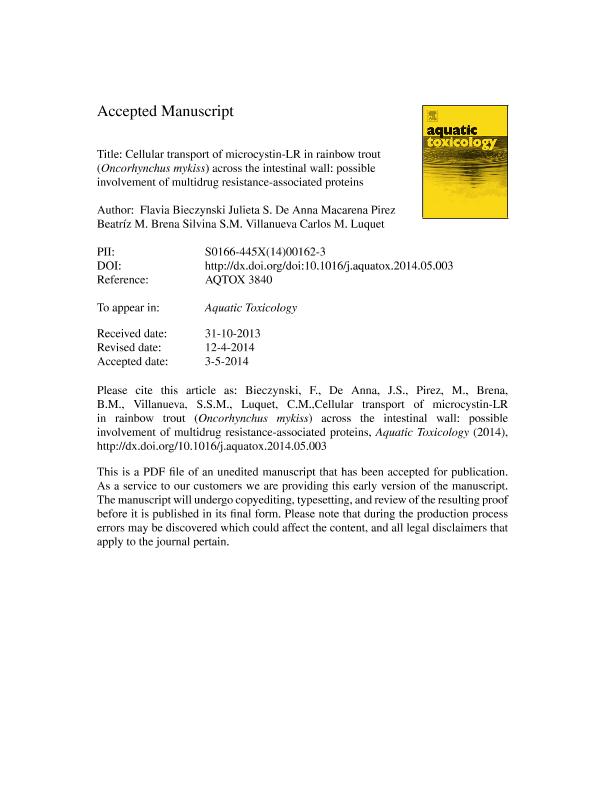Artículo
Cellular transport of microcystin-LR in rainbow trout (Oncorhynchus mykiss) across the intestinal wall: possible involvement of multidrug resistance-associated proteins
Bieczynski, Flavia ; de Anna, Julieta Soledad
; de Anna, Julieta Soledad ; Pirez, Macarena; Brena, Beatriz M.; Villanueva, Silvina Stella Maris
; Pirez, Macarena; Brena, Beatriz M.; Villanueva, Silvina Stella Maris ; Luquet, Carlos Marcelo
; Luquet, Carlos Marcelo
 ; de Anna, Julieta Soledad
; de Anna, Julieta Soledad ; Pirez, Macarena; Brena, Beatriz M.; Villanueva, Silvina Stella Maris
; Pirez, Macarena; Brena, Beatriz M.; Villanueva, Silvina Stella Maris ; Luquet, Carlos Marcelo
; Luquet, Carlos Marcelo
Fecha de publicación:
09/2014
Editorial:
Elsevier Science
Revista:
Aquatic Toxicology
ISSN:
0166-445X
Idioma:
Inglés
Tipo de recurso:
Artículo publicado
Clasificación temática:
Resumen
We studied Abcc mediated-transport in middle and posterior intestine of the rainbow trout, Oncorhynchus mykiss. Luminal and serosal transport were evaluated in everted and non-everted intestinal sacs, respectively, incubated with 1-chloro-2,4-dinitrobenzene (CDNB; 200 μM). CDNB enters the cells and is conjugated with glutathione via glutathione S-transferase (GST) to form 2,4-dinitrophenyl-S-glutathione (DNP-SG), a known Abcc substrate. DNP-SG concentration in the bath was recorded every 10 min, in order to calculate the mass-specific transport rate. For evaluating the possible involvement of Abcc proteins in microcystin-LR (MCLR) transport, 1.135 μM MCLR was added to the bath or inside the sacs, in everted or non-everted preparations, respectively. Both luminal and serosal DNP-SG efflux were significantly inhibited by MCLR. A concentration–response curve obtained using strips from middle intestine yielded an IC50 value of 1.33 μM MCLR. The Abcc inhibitor, MK571 produced concentration-dependent inhibition of DNP-SG similar to that produced by MCLR. Since competition of MCLR and CDNB as GST substrates could bias the DNP-SG transport results, we evaluated the effects of MCLR on calcein efflux, which does not depend on GST activity. We applied the non-fluorescent, cell-permeant compound calcein-AM (0.25 μM) to middle intestinal strips and recorded the efflux of its hydrolysis product, the fluorescent Abcc substrate calcein. 2.27 μM MCLR and 3 μM MK571 inhibited calcein efflux (17.39 and 20.2%, respectively). Finally, MCLR interaction with Abcc transporters was evaluated by measuring its toxic intracellular effects. Middle intestinal segments were incubated in saline solution with 1.135 μM MCLR (MC1), 2.27 μM MCLR (MC2), 3 μM MK571 (MK) or 1.135 μM MCLR + 3 μM MK571 (MC1/MK). After 1 h, GSH concentration, protein phosphatase 1 and 2A (PP1, PP2A) and GST activities were measured in each segment. MC1did not produce significant effect while MC1/MK and MC2 significantly inhibited PP1and PP2A in similar proportions (34–49%). MK alone significantly increased PP2A activity (40%) with no effect in any other variable. GST activity and GSH concentration were not affected by any treatment. Concentration–response curves for MCLR (1.135 to 13.62 μM) alone or plus 3 or 6 μM MK571 were obtained using PP1 activity as response variable. The IC50 values were 1.0, 0.52, and 0.37 μM, respectively. Our results suggest that O. mykiss enterocytes are capable of eliminating MCLR by GST-mediated conjugation and luminal excretion through an Abcc-like apical transporter. This mechanism would prevent toxic effects and reduce the toxin uptake into the blood, which is likely mediated by basolateral Abccs.
Archivos asociados
Licencia
Identificadores
Colecciones
Articulos(INIBIOMA)
Articulos de INST. DE INVEST.EN BIODIVERSIDAD Y MEDIOAMBIENTE
Articulos de INST. DE INVEST.EN BIODIVERSIDAD Y MEDIOAMBIENTE
Citación
Bieczynski, Flavia; de Anna, Julieta Soledad; Pirez, Macarena; Brena, Beatriz M.; Villanueva, Silvina Stella Maris; et al.; Cellular transport of microcystin-LR in rainbow trout (Oncorhynchus mykiss) across the intestinal wall: possible involvement of multidrug resistance-associated proteins; Elsevier Science; Aquatic Toxicology; 154; 9-2014; 97–106
Compartir
Altmétricas



